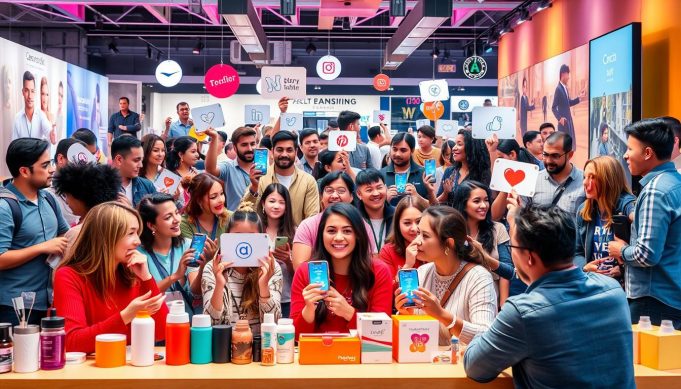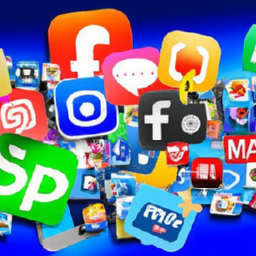In the world of digital marketing, influencer marketing is a big deal. It’s seen as effective by 92% of marketers1 and 86% are ready to spend money on it1. So, what is it, and why is it important?
Influencer marketing uses social media influencers to promote brands. These influencers have a big following and are seen as experts. Over 80% of marketers say influencers are key to their social media plans2. The market is expected to hit $24 billion by 20242. It helps brands get noticed, reach skeptical people, and build real connections.
The popularity of influencer marketing comes from a shift to social media and less trust in ads. People want real connections with brands. Influencers help by reaching out to their fans and using their trust and credibility.
Key Takeaways
- Influencer marketing uses social media influencers to promote brands and drive desired actions.
- Over 80% of marketers consider influencers key to their social media strategy, and the industry is projected to grow to $24 billion in 2024.
- Influencer marketing allows brands to cut through the noise, reach skeptical consumers, and establish authentic connections.
- Consumers today seek genuine connections with brands, which is where influencers can provide value.
- Collaborating with relevant influencers can help brands tap into loyal followings and leverage trust and credibility.
Understanding the Evolution of Digital Marketing
The world of digital marketing has changed a lot. It moved from old ways to focusing more on social media3. Social media has made it easier for people to talk to brands in new ways. Now, being real and connecting deeply with people is key, thanks to millennials and Gen Z valuing authenticity3.
The Shift from Traditional to Social Media Marketing
Social media has changed how brands talk to people. Sites like Instagram, YouTube, TikTok, and Twitch are now key for influencer marketing4. This has helped brands connect better with people, building trust and credibility that old ads often can’t match.
The Rise of Consumer Skepticism
People are now more careful and don’t trust self-promotion and obvious ads3. They want brands to be real and open. Influencers are seen as reliable for honest product advice and insights4.
The Need for Authentic Brand Voices
Brands know they need to be real to win trust3. Influencer marketing is a big help here. It uses social media stars to share real messages that connect with people4.
This change in digital marketing makes influencer marketing very important. Brands aim to make real connections, gain trust, and get results through honest communication34.
| Influencer Type | Follower Range |
|---|---|
| Macro-influencers | Hundreds of thousands or millions of followers4 |
| Micro-influencers | Thousands or tens of thousands of followers3 |
| Nano-influencers | Fewer than 10,000 followers4 |
“Influencer marketing has become a critical component of modern digital marketing strategies, addressing the growing demand for authentic brand communication and genuine connections with consumers.”
Defining Influencer Marketing
Influencer marketing is when businesses team up with people who have a big following on social media. They use these influencers’ trust and influence to promote their products or services5. This method helps increase brand awareness and change how people think about a brand.
It’s all about working with influencers to make interesting content. They might do giveaways, Q&A sessions, or even manage a brand’s social media5. The goal is to use the influencer’s realness to make the brand seem more authentic and visible.
The influencer marketing world was worth $21.1 billion in 20235. This shows how big and important it has become. More and more brands are seeing the value in influencer collaboration and social media partnerships for promoting their brand.
In 2019, 54% of millennials and Gen Zers wanted to be influencers5. This shows how popular and promising this field is. With more people doubting traditional ads, real voices and influencer collaboration are key for good brand promotion and social media partnerships.
“Influencer marketing is a game-changer in the digital age, allowing brands to connect with their audience in a more genuine and impactful way.”
The Power of Social Media Influence
Social media influencers have become key players in the digital world. They help brands reach out to their online followers. These influencers build trust through real connections, something ads can’t do6.
Building Trust Through Online Communities
Influencers create communities where they share their lives and thoughts. This honesty builds trust with their followers. Their advice is seen as valuable7.
The Role of User-Generated Content
User-generated content (UGC) makes influencer marketing more real and engaging. It stands out from regular ads, connecting better with people. This approach boosts trust and leads to more sales6.
Creating Authentic Connections
Influencers connect with their followers on a personal level. They share their lives, building trust and loyalty. This approach makes their marketing more effective7.
Social media influencers have a big impact, shaping consumer choices and business success. Brands that work with them see better awareness, engagement, and sales678.
Types of Influencers and Their Impact
The world of influencer marketing is always changing. It’s key to know the different types of influencers and what they bring to the table. Influencers are grouped by their number of followers. Each group has its own role in helping brands and shaping marketing plans.
Mega-influencers have more than 1 million followers. They are like celebrities and can help brands get noticed by many people. But, they might not be as relatable as other influencers9.
Macro-influencers have between 100,000 and 1 million followers. They offer a good mix of wide reach and engaged fans. They often have careers in creating content and can promote products well to their followers10.
- Micro-influencers have 10,000 to 100,000 followers. They have very engaged fans and can help brands get more sales. They are experts in certain areas and are very relatable10.
- Nano-influencers have 1,000 to 10,000 followers. They focus on being real and authentic. Their small, loyal groups can have a big impact, as they are seen as trusted voices in their niches10.
Nano-influencers are becoming more popular, with 44% of brands wanting to work with them in 2024. This shows how important being real, engaging with communities, and being cost-effective are in influencer marketing9.
| Influencer Type | Follower Count | Key Characteristics |
|---|---|---|
| Mega-influencers | 1M+ | Broad reach, celebrity-like status |
| Macro-influencers | 100K-1M | Balanced reach and engagement |
| Micro-influencers | 10K-100K | Highly engaged niche communities |
| Nano-influencers | 1K-10K | Authentic, trusted voices in specific niches |
It’s vital for brands to know what each influencer type offers. This helps them use influencer marketing better and get the most out of their partnerships91011.
“Influencers with relatable personalities garner trust from 60%-70% across different demographics, while influencers with expert personalities secure the trust of 50%-58% of individuals.”9
Why Brands Are Investing in Influencer Marketing
Brands are seeing the big benefits of influencer marketing. In 2023, the global influencer marketing market hit $21.1 billion12. Also, 89% of marketers who used it last year plan to spend more on it12. This growth is because influencer marketing can bring in big returns, with an average of $6.50 for every $1 spent12.
ROI and Performance Metrics
Influencer marketing is a top choice for many, thanks to its success. Micro-influencers can get up to 60% more engagement than big influencers12. This means more people see and interact with brands, leading to better ROI.
Brand Awareness Benefits
Brands can reach new people through content creators. Short videos, like those on TikTok and Instagram, are super engaging for 75% of consumers12. This makes these platforms key for influencer campaigns.
Audience Engagement Advantages
Influencer marketing helps target the right audience and boosts sales. Almost three-quarters of millennials and Gen Zers follow influencers12. Also, 50% of millennials trust what influencers say about products12. And, 33% of Gen Zers have bought something based on an influencer’s advice in the last three months12.
As marketing changes, influencer marketing is becoming more important. It’s great for getting people to know your brand, engaging with your audience, and making a good profit. It’s why smart marketers are focusing on it more and more.
“Influencer marketing enables precise audience targeting and higher conversions, with nearly three-quarters of millennials and Gen Zers following influencers on social media.”
Success Stories in Influencer Marketing
Influencer marketing has become a key strategy for brands to reach their audience. It works across many sectors, from fashion to beauty and more. This shows how powerful social media influencers can be13.
Daniel Wellington, a Swedish watch brand, grew fast thanks to Instagram influencers. They gave out products and asked influencers to share with branded hashtags. This led to over 1 million Instagram followers in just a year, making it one of Europe’s fastest-growing companies13.
H&M teamed up with fashion blogger Julie Sarinana for its 2017 catalog. This partnership showed how influencer marketing can boost engagement and awareness in fashion13.
In beauty and personal care, influencer partnerships have also been a hit. Glossier’s “#GlossierRep” campaign turned loyal customers into brand ambassadors. They shared their experiences with Glossier products, leading to high engagement rates14.
Influencer marketing has changed the game for many brands. It helps build trust, increase awareness, and deliver results. That’s why more businesses are jumping on this powerful strategy13.

Stories like H&M and Daniel Wellington’s fashion collaborations and Glossier’s focus on customers show influencer marketing’s strength. As the field grows, we’ll see more creative and effective campaigns using social media influence14.
Building an Effective Influencer Strategy
Creating a winning influencer marketing strategy takes careful planning. First, you must pick the right influencers who match your brand’s values and speak to your audience15. It’s vital to choose influencers who fit your campaign goals for success15.
Setting clear goals for your campaign is also key. You might want to boost brand awareness, drive sales, or engage more with your audience15. Having clear goals and ways to measure them is essential for a successful strategy15. Goals like increasing brand awareness, site traffic, and conversions need different tracking methods15.
Measuring Success
It’s important to measure how well your influencer campaign is doing. Look at engagement metrics like likes, impressions, shares, comments, and mentions15. Also, track web traffic from influencer campaigns to see their impact15. By watching these numbers, you can learn and improve your future influencer partnerships15.
Building trust with your audience is a big win from a good influencer strategy15. The authenticity and trust influencers have with their followers help your brand’s image15. Working with influencers again can grow this trust even more15. It’s important to let influencers be themselves while guiding them a bit to keep things real15.
By following these tips, brands can make a strong influencer marketing plan. This plan will help you reach your goals and connect better with your audience1516.
The Impact on Brand Credibility and Trust
Influencer marketing is a key tool for brands wanting to boost their credibility and gain consumer trust. It uses the influence and authenticity of respected individuals to share messages. This approach helps brands connect with their audience in a more genuine way17.
Consumers trust influencers more than brands themselves. Around 63% of people trust what influencers say about products more than brands do18. This trust acts as a powerful endorsement, helping to establish the brand’s reputation.
Influencer content often feels more real and relatable than traditional ads. This is key in today’s world where people are wary of corporate messages18. By working with influencers who share their values, brands can build a stronger emotional connection with customers.
The impact of influencer marketing is clear. Over 90% of marketers see it as effective in boosting brand awareness and perception17. Also, 63% of consumers value authenticity when choosing brands18. This trust leads to increased loyalty and purchasing, with 86% of consumers making a purchase inspired by an influencer each year17.
By using influencer marketing, brands can quickly build credibility, even in new markets or with new products. It helps them stand out online and build lasting connections with their audience. This drives business growth and success.
| Metric | Value |
|---|---|
| Global value of influencer marketing | $21.1 billion in 202319 |
| Trust in influencers | Increased from 51% in 2019 to 61% in 202319 |
| Engagement rate considered good for influencers | Between one and five percent19 |
| Influencer follower counts | Micro-influencers: 10,000 to 50,000 followers Mega-influencers: over one million followers19 |
“Over 70% of millennials prefer recommendations from peers over traditional advertising.”18
As influencer marketing grows, brands that use it well can gain a big advantage. They can build strong credibility and trust with consumers.
Leveraging User-Generated Content Through Influencers
User-generated content (UGC) is a key tool for brands to connect with their audience. By using influencers, brands can get authentic and engaging content. This content resonates with consumers20.
Content Creation Best Practices
Influencers can create various content types, like photos, videos, and stories. This gives brands a wide range of UGC. It shows products or services in a real way and works well on different social media platforms20.
Repurposing Influencer Content
Repurposing influencer content can greatly help a brand’s marketing. It lets brands share content on different channels, reaching more people. This boosts credibility and engagement20.
Also, influencer content lets brands control their message. It ensures content fits their brand identity20. Influencer networks help create UGC and IGC at scale, making high-quality content20.
Influencers help brands reach more people and influence buying decisions21. Mixing UGC marketing with influencer posts engages both current and future customers20.

Using user-generated content and influencer marketing together boosts brand awareness and engagement. It also drives customer conversions2021.
| Product Category | Percentage of Consumers Who Find UGC Most Valuable |
|---|---|
| Clothing | 78% |
| Electronics | 70% |
| Appliances | 63% |
| Home and Garden | 62% |
| Health and Beauty | 60% |
Consumers value UGC most for certain products like clothing, electronics, and more20.
“User-generated content (UGC) is becoming increasingly important in marketing strategies. Influencer-generated content (IGC) helps brands control the narrative and shape content that aligns with their brand identity.”
Platform Selection for Influencer Campaigns
Choosing the right social media platforms is key for influencer marketing success. People use different platforms for shopping and learning about products22. The 2025 Influencer Marketing Impact Report shows YouTube, Instagram, Facebook, TikTok, and Snapchat are top for content. For product reviews, YouTube, Instagram, Facebook, TikTok, and Reddit are the best22.
Brands should think about their audience, the platform’s strengths, and campaign goals when picking platforms23. Most marketers look at 5-8 platforms, focusing on finding influencers, managing campaigns, and measuring ROI23.
Influencer marketing platforms like Aspire make choosing easier23. Aspire’s search engine lets you filter by keywords and demographics. It also connects brands with over 1 million influencers23. Plus, it integrates with Shopify for better customer profiles23.
When picking platforms, look at how they handle fake accounts and offer influencer marketplaces23. Also, check if they have analytics for tracking performance23. Platforms with automatic content rights and ad amplification make marketing easier23.
By picking the right platforms, brands can connect with their audience, build trust, and get a good return on investment222423.
“Brands should consider their target audience’s preferences and the platform’s strengths when selecting where to run influencer campaigns.”
Budget Considerations and ROI Expectations
The cost of influencer marketing budget can vary a lot. Mega-influencers with lots of followers can charge thousands for a post25. On the other hand, nano- and micro-influencers, who get more engagement, cost less, from $50 to $250 per post25. Brands need to think about the balance between reach and engagement when setting their budget.
It’s important to match ROI expectations with campaign goals. While getting people to know your brand is key, looking at engagement and sales can show if a campaign works26. Marketers can get up to $18 in value for every dollar spent on influencer marketing26. Yet, 33% of brands don’t check their ROI, and only half know how to do it right26.
The influencer marketing industry is expected to grow to $24 billion by 202425. This shows its big role in marketing budgets. Brands should look at their campaign costs and influencer fees to make sure they’re getting a good deal and meeting their marketing goals.
| Influencer Type | Typical Fees |
|---|---|
| Nano-Influencers (1K – 10K followers) | $10 – $250 per post26 |
| Micro-Influencers (10K – 50K followers) | $500 – $5k per post26 |
| Macro-Influencers (500K – 1M followers) | $5K – $10K per post26 |
| Mega-Influencers (1M+ followers) | $10K+ per post26 |
To see if an influencer campaign works, brands can look at engagement, website visits, and sales26. By knowing what they expect in return and balancing costs with benefits, brands can make their influencer marketing more effective.
“Kim Kardashian reportedly received over 1 Million Dollars for a single post.”25
Conclusion
Influencer marketing is now a key part of digital marketing plans. Over27 80% of marketers see it as vital for their social media success. It’s great for building trust, reaching specific groups, and boosting sales.
The world of influencer marketing is changing fast. Micro and nano influencers are becoming more popular, alongside big-name stars. To do well, brands need to create real partnerships, mix up their influencer choices, and match their plans to each platform’s unique vibe28.
The future of influencer marketing is all about using data, exploring new platforms, and keeping up with what people want. By being quick to adapt and creative, brands can make the most of influencer marketing future, digital marketing trends, and social media strategy. This will help them build trust, get people involved, and reach their goals. The journey is ongoing, and we’re eager to see what’s next.
FAQ
What is influencer marketing and why do we need it?
How has digital marketing evolved over time?
What is the definition of influencer marketing?
How do social media influencers impact brands?
What are the different types of influencers and their benefits?
Why are brands investing in influencer marketing?
Can you provide examples of successful influencer marketing campaigns?
How can we develop an effective influencer marketing strategy?
How does influencer marketing impact brand credibility and trust?
How can brands leverage user-generated content from influencers?
How do we choose the right platform for influencer campaigns?
What budget considerations should we keep in mind for influencer marketing?
Source Links
- Why Influencer Marketing Is Important | GRIN – https://grin.co/blog/why-influencer-marketing/
- What is influencer marketing: An influencer strategy guide for 2024 – https://sproutsocial.com/insights/influencer-marketing/
- Evolution Of Influencer Marketing In Digital Ads – https://www.velocityconsultancy.com/adapting-to-the-future-how-influencer-marketing-is-changing-the-face-of-digital-advertising/
- The Evolution of Influencer Marketing: Harnessing the Power of Digital Influencers – https://www.linkedin.com/pulse/evolution-influencer-marketing-harnessing-power-digital-u3t8c
- What is influencer marketing? – https://www.mckinsey.com/featured-insights/mckinsey-explainers/what-is-influencer-marketing
- The Power of Influencer Marketing – https://www.prsa.org/article/the-power-of-influencer-marketing
- The persuasive power of social media influencers in brand credibility and purchase intention – Humanities and Social Sciences Communications – https://www.nature.com/articles/s41599-023-02512-1
- Social Media Influencers: A Complete Guide for 2024 – https://influencity.com/blog/en/social-media-influencers-everything-you-need-know-about-them
- Teleprompter | Types of Influencers Reshaping Digital Marketing – https://www.teleprompter.com/blog/types-of-influencers
- Top 10 Types of Influencers for Your Brand | Moburst – https://www.moburst.com/blog/types-of-influencers/
- 26 Types of Influencers You Need to Follow in 2024 – https://taggbox.com/blog/types-of-influencers/
- Council Post: The Power Of Influencer Marketing: Your Strategic Investment For Success – https://www.forbes.com/councils/forbesagencycouncil/2024/01/05/the-power-of-influencer-marketing-your-strategic-investment-for-success/
- 8 Insane (But True) Influencer Marketing Case Studies | Trend – https://www.trend.io/blog/influencer-marketing-case-studies
- 9 Examples of Successful Influencer Marketing Campaigns – Influencity Blog – https://influencity.com/blog/en/9-examples-of-successful-influencer-marketing-campaigns
- How to Build a Successful Influencer Strategy – https://www.meltwater.com/en/blog/how-to-build-a-successful-influencer-strategy-with-the-right-social-channels
- How to Develop an Effective Influencer Marketing Strategy – https://www.brandwatch.com/blog/influencer-marketing-strategy/
- The Impact of Influencer Marketing on Brand Perception – https://www.linkedin.com/pulse/impact-influencer-marketing-brand-perception-phnxglobal-3zgwf
- The Importance of Authenticity in Influencer Marketing – The Cirqle – https://thecirqle.com/blog-post/the-importance-of-authenticity-in-influencer-marketing
- The Power of Influencer Marketing: Collaboration, Brand Awareness and Authenticity – https://online.mason.wm.edu/blog/the-power-of-influencer-marketing
- UGC Content: How to Leverage Influencers for UGC | Trend – https://www.trend.io/blog/user-generated-content-influencer-generated-content
- UGC: Leveraging Influencers for Powerful User-Generated Content – https://www.sevenatoms.com/blog/influencers-user-generated-content
- Top US Social Platforms for Influencer Marketing I Traackr – https://www.traackr.com/blog/social-media-platform-influencer-marketing
- 11-Step Checklist to Choosing the Right Influencer Marketing Platform | Aspire – https://www.aspire.io/blog/how-to-choose-influencer-marketing-platform
- Top 16 influencer marketing platforms for your 2024 campaigns – https://sproutsocial.com/insights/influencer-marketing-platforms/
- Influencer Marketing Budgets – Everything You Need to Know to Build One – A Step-by-Step Guide – Flaminjoy – https://www.flaminjoy.com/blog/influencer-marketing-budget/
- Influencer Marketing ROI: Metrics and Strategies for Success – https://www.socialpilot.co/blog/influencer-marketing-roi
- Benefits and challenges of influencer marketing – SmartBrief – https://www.smartbrief.com/original/benefits-and-challenges-of-influencer-marketing
- The power of influencer marketing in growth marketing – https://abmatic.ai/blog/power-of-influencer-marketing-in-growth-marketing












